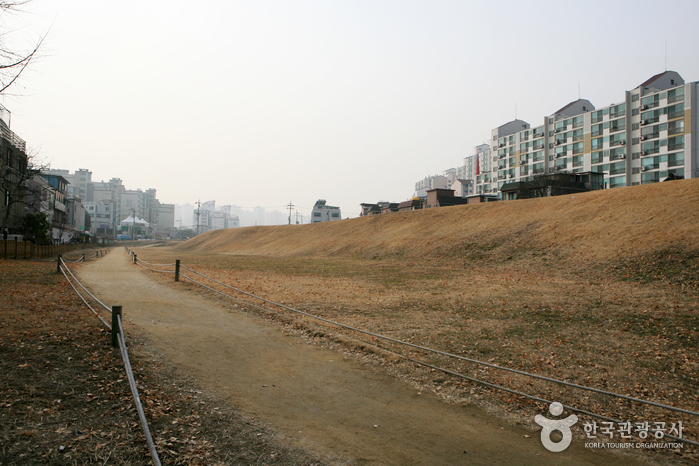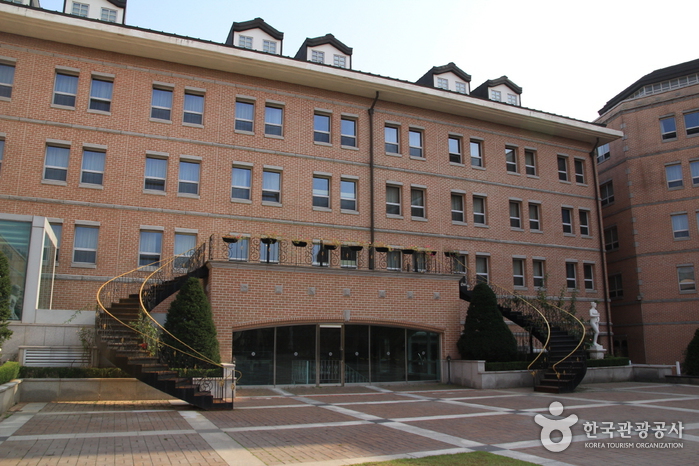Lotte Himart - Junggye Lotte Mart Branch [Tax Refund Shop] (롯데하이마트 중계롯데마트점)
13.4Km 2024-04-22
330, Nowon-ro, Nowon-gu, Seoul
-
Lotte Mart - Junggye Branch [Tax Refund Shop] (롯데마트 중계점)
13.4Km 2024-04-22
330, Nowon-ro, Nowon-gu, Seoul
-
Pungnap-dong Toseong Fortress (서울 풍납동 토성)
13.4Km 2025-01-10
Pungnap-dong, Songpa-gu, Seoul
+82-2-2147-2800
Onjo, the progenitor of Kingdom Baekje, first settled in Wiryeseong Hanam. But exact location is still unknown. One thing for sure, however, is that Pungnaptoseong Fortress, Mongchontoseong Fortress, Bangidong Ancient Tombs of Baekje, Seokchondong Stone Mound Tomb of Early Baekje are the remains of Baekje. Pungnaptoseong Fortress faces Hangang River to its west and connects to Mongchontoseong Fortress to the south. To the northwest faces Achasanseong Fortress over Hangang River and far to the southeast is Namhansanseong Fortress.
Pungnaptoseong Fortress, located at the south end of Cheonhodaegyo Bridge over Hangang River, is one of the remains of Early Baekje. Originally, the fortress was 4km in circumference, but due to massive overflowing of Hangang River during flood season in 1925, most of the fortress was lost and only 2.7km of it remains. To the east of the fortress are 4 vestiges of the fortress gates. The remains from the prehistoric era through the Samguk (Three States) era have been unearthed, indicating that this place was a residential area well before the Baekje Era. Through vigorous excavation, some people suggest that there used to be a palace located here during the Baekje Era.
Ononsa Guesthouse (온온사)
13.4Km 2023-07-17
58 Gwanaksan-gil, Gwacheon-si, Gyeonggi-do
Though Ononsa, which was a guesthouse in Gwacheon, was constructed in the 27th year of King Injo's reign in the Joseon dynasty (1649), the name, "Ononsa," was given to this area during the reign of King Jeongjo. On February 11, 1790 during his royal procession to the tomb of his father, Crown Prince Sado, stayed at an inn in Gwacheon and, as he felt that it "has nice views and provides a comfortable stay," he bestowed upon the place plaques that he wrote himself - "Ononsa" to Seoheon and "Burimheon," which was the old nickname of Gwacheon, to Dongheon. This is how this place began to be called Ononsa.
It was designated as a Tangible Cultural Heritage of Gyeonggi-do on June 2, 1980, and it was restored on December 2, 1986 after being torn down.
Olive Young - Gwangmyeong Sageori Station Branch [Tax Refund Shop] (올리브영 광명사거리역)
13.5Km 2024-04-18
897, Gwangmyeong-ro, Gwangmyeong-si, Gyeonggi-do
-
Olive Young - Nowon Station Sageori Branch [Tax Refund Shop] (올리브영 노원역사거리)
13.5Km 2024-04-17
1F, 480, Nohae-ro, Nowon-gu, Seoul
-
Philkyungjae (필경재)
13.5Km 2024-03-07
205, Gwangpyeong-ro, Gangnam-gu, Seoul
+82-2-445-2115
Philkyungjae is a restaurant serving traditional Korean cuisine served in the royal courts of Joseon. Its course menu includes jeonbokjuk (abalone porridge), bossam (napa wraps with pork), sogogi japchae (beef japchae), tteokgalbi (grilled galbi patties), and hanu yukhoe (Korean beef tartare). There are five courses on offer. All five courses are available during lunch, while dinnertime limits the selection to three. The restaurant is housed in a traditional house and garden dating back to the Joseon Dynasty (1392-1910), so guests can enjoy the architectural beauty of Korea with Korean flavors. Reservations can be placed through telephone.
ABC Mart - Nowon Branch [Tax Refund Shop] (ABC마트 노원점)
13.5Km 2024-06-28
482, Nohae-ro, Nowon-gu, Seoul
-
Olive Young - Wonheung Station Branch [Tax Refund Shop] (올리브영 원흥역점)
13.6Km 2024-06-26
#101, #102, #107, and #108, 668, Gwonyul-daero, Deogyang-gu, Goyang-si, Gyeonggi-do
-
Mayfield Hotel Seoul (메이필드호텔 서울)
13.6Km 2025-10-23
94, Banghwa-daero, Gangseo-gu, Seoul
+82-2-2660-9200
Surrounded by forests, Mayfield Hotel is the ideal place to enjoy unique seasonal views and unite with nature. It takes five minutes from Gimpo International Airport and 30 minutes from Incheon International Airport, boasting a proximity to both downtown and the airports. Mayfield Hotel staff members are dedicated to providing the best services with the utmost care. It is a premium hotel where guests experience the joys of comfortable and relaxed travels while creating valuable memories. Mayfield Hotel is located next to the traditional Korean restaurant Nakwon, which serves premium Korean cuisine. The hotel spans an area of approximately 105,785.60 square meters, and has six floors and a basement level. The hotel consists of eight separate buildings, including the main hotel wing, which houses an elegant lounge; a Western restaurant; a traditional Korean restaurant; and an outdoor plaza lounge. There is a banquet wing with a hall that can accommodate international conferences, plus various events and banquets. Small and medium-sized banquet halls suitable for weddings and receptions are available as well. The hotel wing has 202 spacious and cozy guest rooms, including suites and traditional Korean-style ondol rooms that guests can choose from depending on their preference. Notably, the hotel boasts top-tier facilities, such as a state-of-the-art fitness club and a botanical garden, showcasing the hotel's exceptional features.
![Lotte Himart - Junggye Lotte Mart Branch [Tax Refund Shop] (롯데하이마트 중계롯데마트점)](http://tong.visitkorea.or.kr/cms/resource/28/2890228_image2_1.jpg)



![Olive Young - Nowon Station Sageori Branch [Tax Refund Shop] (올리브영 노원역사거리)](http://tong.visitkorea.or.kr/cms/resource/71/2888271_image2_1.jpg)
![ABC Mart - Nowon Branch [Tax Refund Shop] (ABC마트 노원점)](http://tong.visitkorea.or.kr/cms/resource/05/3312805_image2_1.jpg)

 English
English
 한국어
한국어 日本語
日本語 中文(简体)
中文(简体) Deutsch
Deutsch Français
Français Español
Español Русский
Русский